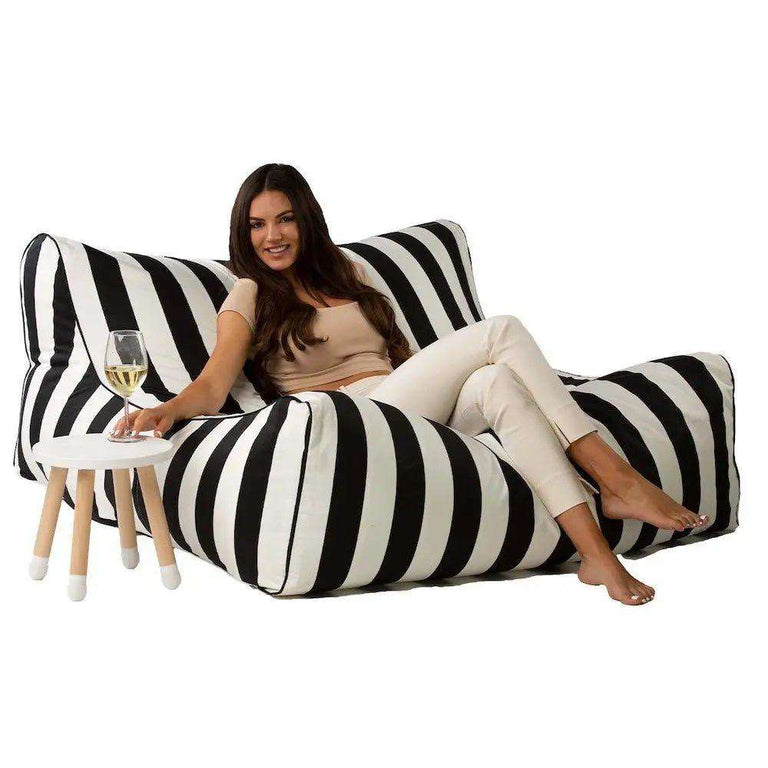Choosing the right fabric for your outdoor bean bag chairs will ensure you purchase a product that withstands the elements & gives you the longest life. Resin wicker, for example, is weather-resistant, UV-resistant, and requires low maintenance, making it ideal for outdoor settings. Different outdoor furniture materials each respond uniquely to Melbourne's weather conditions, so it's important to consider how each material performs under moisture, UV exposure, and temperature changes.
When selecting the material for outdoor bean bag chairs, it’s essential to consider a blend of durability, comfort, and weather resistance. Your outdoor space deserves stylish yet functional seating that withstands sun, rain, and everyday wear, whether for patios, gardens, balconies, or other outdoor spaces. With numerous options on the market, it's important to compare different outdoor furniture materials for their suitability, maintenance needs, and aesthetics. Understanding which fabrics perform best outdoors and selecting the right outdoor material ensures durability and longevity for your furniture. Aluminium, for instance, is lightweight and resistant to rust and corrosion, requiring little maintenance.
What Makes a Material Ideal for Outdoor Bean Bag Chairs?
The ideal material for outdoor bean bag chairs must resist UV rays, moisture, mildew, and rough use. Outdoor furniture often faces extreme conditions, so choosing a suitable fabric is critical. When selecting outdoor materials, it's important to consider climate and usage to ensure long-term durability and comfort. Common requirements include breathability, ease of cleaning, fade resistance, and structural integrity, all of which depend on the properties of the furniture material. Without the right choice, your chair may degrade quickly under outdoor elements. Regular cleaning is also essential to prevent mould and mildew growth, regardless of the material.
Some fabrics excel under pressure, while others look great but fall short on performance. Your decision should reflect your outdoor environment and how frequently the chair will be used. Identifying the best furniture material depends on your specific needs and climate, as different materials offer varying levels of weather resistance and maintenance. Do you need something rugged for poolside relaxation or soft for shaded patios? Answering these questions helps guide your selection process. The visual appeal of outdoor furniture materials also significantly impacts the ambience of outdoor living spaces.
1. Olefin: Durable and Affordable
Olefin is a synthetic fiber designed specifically for outdoor use. As one of many synthetic materials used in outdoor furniture, it offers benefits such as enhanced weather resistance, moldability, and eco-friendliness compared to natural options. It resists stains, mildew, moisture, and UV rays, making it a leading choice for bean bag covers. This material holds colour well and dries quickly, minimising long-term damage from sun exposure and rain. Olefin is also environmentally friendly since it can be recycled with minimal environmental impact. Similarly, synthetic resin wicker offers high durability and weather resistance, and outdoor furniture made from plastic materials—especially high-density polyethylene (HDPE)—provides superior strength, UV resistance, and long-lasting performance compared to lower-quality plastics.
Another major benefit is affordability. Compared to other outdoor fabrics, olefin offers high value at a lower cost. It’s lightweight and holds its shape well, making it perfect for bean bags that move often or need regular cleaning. Olefin’s smooth finish also prevents dirt from embedding deeply into the fabric.

2. Solution-Dyed Acrylic: Premium and Weather-Resistant
Solution-dyed acrylic is widely used in marine and patio furniture. It’s dyed before the fibres are formed, making its colour fade-resistant even under intense sunlight. Known for its softness and water-repellent qualities, this material balances comfort and durability beautifully. Brands like Sunbrella popularised it in the outdoor furniture industry. Sunbrella fabrics are recognised as some of the best outdoor materials due to their exceptional durability, UV resistance, and reputation for long-lasting performance.
While more expensive than other fabrics, solution-dyed acrylic provides unmatched longevity and style. It resists mould, mildew, and fading, making it ideal for all-season use. Additionally, it’s easy to clean with mild soap and water, making maintenance a breeze for homeowners, an important factor for outdoor upholstery to maintain comfort and longevity.
How to Compare Materials for Outdoor Bean Bag Chairs
Not all materials are created equal. When choosing the right material for outdoor bean bag chairs, evaluate the following attributes: resistance to moisture, UV protection, colour retention, texture, and maintenance. Different materials offer varying levels of durability and performance, so it's important to compare their strengths. A high-quality fabric should retain its look and feel after exposure to sun, rain, and dirt. Choose fabrics engineered for outdoor use, not repurposed indoor materials, and prioritise the best materials for longevity.
Another key factor is comfort. Some weatherproof materials can feel coarse or plastic-like. If your bean bag will be used for lounging, ensure the fabric is soft enough to relax on. When considering comfort, also look for options that balance softness with the use of durable materials. Some fabrics use additional coatings for waterproofing that can affect comfort, so always test or read reviews before purchase.
3. Polyester with PVC Backing: Budget-Friendly Protection
Polyester with PVC backing is an economical option that offers solid protection against moisture. The PVC coating adds waterproofing and rigidity, helping the bean bag maintain its structure. It also prevents water absorption, reducing the chances of mildew buildup inside the filler. Many budget-friendly outdoor furniture options also use recycled plastic, which is sustainable, durable, and requires little upkeep.
However, these bean bags might not be as breathable as others, which could make them less comfortable during hot weather. They’re great for occasional use or shaded areas. You can also use them under a covered patio or porch for a longer lifespan and a better experience, and benefit from minimal maintenance required for these types of materials.
4. Marine Vinyl: Heavy-Duty and Waterproof
Designed for boats and marine upholstery, marine-grade vinyl is incredibly durable and completely waterproof. It’s perfect for environments with heavy rain or poolside use. Marine vinyl is also resistant to salt, chlorine, UV rays, and even sunscreen oils, making it suitable for the most demanding outdoor settings. Additionally, its robust construction allows it to withstand extreme weather and salt air, making it ideal for coastal areas and harsh outdoor conditions.
On the downside, it may feel less natural than textile fabrics. However, it can be an excellent solution for bean bags that prioritise protection over plushness. Marine vinyl is also extremely easy to wipe down, requiring minimal upkeep compared to woven materials, but proper care is still important to maintain its protective qualities.

Maintenance Tips for Outdoor Bean Bag Materials
Maintaining your material for outdoor bean bag chairs ensures they last season after season. Always check the manufacturer’s instructions before using any cleaning products. Most outdoor fabrics respond well to mild soap and water. For stubborn stains, a vinegar solution or fabric cleaner may help. Organic materials and natural materials, such as wood or rattan, may require special care to prevent mould, rot, or other issues related to their biodegradability and environmental impact.
To prolong your bean bag’s lifespan, store it indoors or use a waterproof cover when not in use. Regularly brushing off dirt and rinsing with clean water prevents buildup that could cause stains or odours. Also, avoid harsh bleach or abrasive cleaners that can degrade the protective coatings. Certain woods, like teak or eucalyptus, have natural resistance to weathering and pests due to their natural oils, which can reduce maintenance needs compared to other materials.
5. Canvas and Treated Cotton: Classic Look, Limited Protection
Canvas and treated cotton blends are natural-looking materials that offer classic style. Many outdoor furniture pieces also use traditional materials such as rattan, bamboo, reed, and willow, which are crafted into traditional wicker for a timeless look. While not inherently weather-resistant, these fabrics can be treated with waterproof sprays or coatings. They’re more breathable than synthetic fabrics, making them feel cooler in the summer, similar to the comfort provided by natural wicker and wood furniture, which are also classic options for outdoor seating.
However, these materials require more care and are best used in shaded or covered areas. They’re more prone to fading and mildew than synthetic options, so use them where they’ll remain dry. If you prioritize aesthetics and light use, treated canvas may be an attractive option.
Style and Design Considerations for Outdoor Bean Bag Chairs
When designing your outdoor living space, the style and design of your outdoor bean bag chairs can make a significant impact on both comfort and visual appeal. The right outdoor furniture materials not only enhance the look of your patio or garden but also ensure your seating remains inviting and functional through changing seasons.
Selecting the best outdoor furniture materials means considering more than just colour or shape. Materials like solution-dyed acrylic, olefin, and marine vinyl offer a sleek, modern appearance while providing the weather resistance needed to withstand harsh outdoor conditions. These fabrics come in a wide range of colours and patterns, allowing you to coordinate your bean bag chairs with other outdoor furniture and décor for a cohesive look.
Durability is just as important as style. High-quality furniture materials maintain their shape and colour even after prolonged exposure to sun, rain, and wind, ensuring your outdoor living space always looks its best. Opting for materials specifically engineered for outdoor use means your bean bag chairs will resist fading, mildew, and wear, keeping your outdoor living area fresh and inviting.
Ultimately, the best outdoor furniture materials strike a balance between style, comfort, and resilience. By choosing weather-resistant fabrics and designs that complement your outdoor décor, you can create a stylish, comfortable retreat that stands up to the demands of outdoor living. Whether your taste leans toward bold, contemporary patterns or classic, understated hues, there are outdoor bean bag chairs to suit every design vision and withstand the elements for years to come.
Summary: Best Fabrics for Outdoor Bean Bag Comfort and Longevity
Choosing the right material for outdoor bean bag chairs is essential for balancing comfort, style, and resilience. Each material has unique strengths depending on your needs. Olefin and solution-dyed acrylic are top performers for most settings, offering a mix of comfort, weatherproofing, and low maintenance. Marine vinyl and PVC-backed polyester are ideal for heavy-duty or poolside use. Selecting the best outdoor materials is crucial for creating highly durable outdoor garden furniture that withstands environmental stressors and maintains its integrity over time.
Consider how often you’ll use the bean bag and under what conditions. A shaded deck may need a different fabric than a sunny, salt-exposed patio. The right outdoor materials play a key role in ensuring your outdoor furniture investment continues to deliver comfort and style through every season, providing long-term performance and durability.
Final Thought
The next time you're shopping for patio seating, don't overlook the importance of choosing the right material for outdoor bean bag chairs. With this guide, you can confidently pick a fabric that complements your lifestyle and handles the elements with ease.




